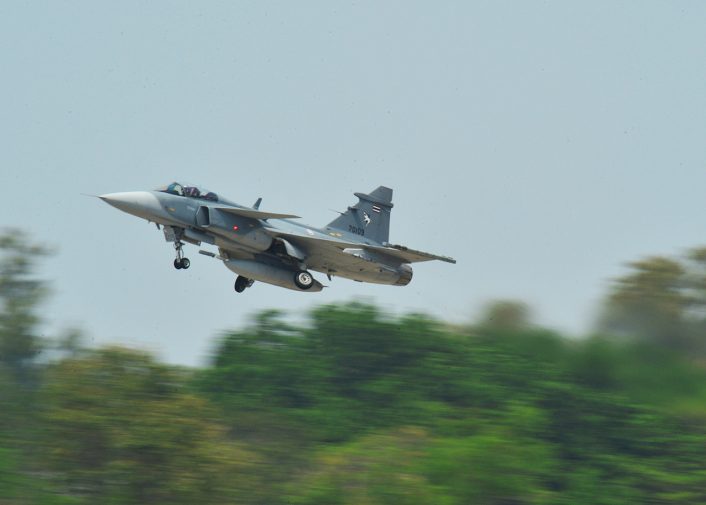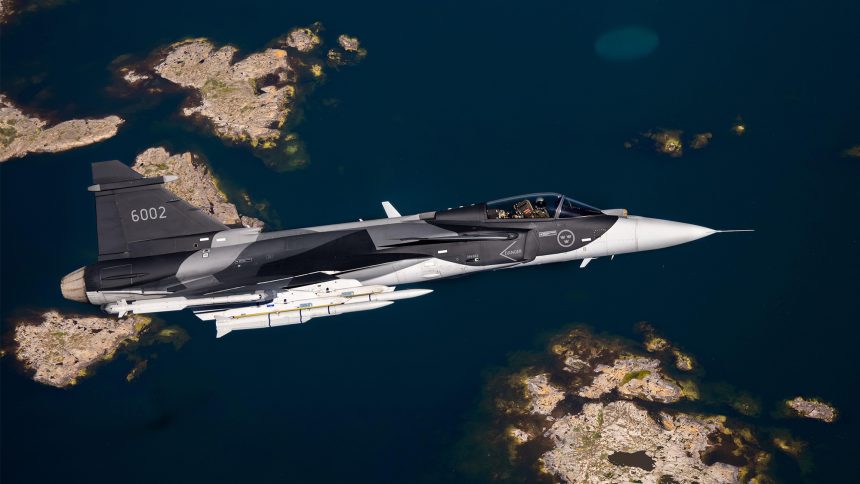Saab has confirmed the Royal Thai Air Force’s choice of the Gripen E/F to replace the force’s F-16s, and the formal procurement process can now begin.
The Royal Thai Air Force (RTAF) announced its preference in August 2024 to acquire Saab’s next generation Gripen, beating out a Lockheed Martin proposal offering Block 70/72 F-16 Fighting Falcons. The air force’s decision still required formal approval from the Thai Government, although signals from ministers suggested this was not a highly contentious proposal.
On Jun. 4, 2025, Saab issued a press release stating that the selection had been confirmed. No formal contract or order has yet been signed, but the approval means official negotiations are now able to begin between Thailand, Saab, and Sweden’s Defence Materiel Administration who manage the country’s foreign military sales.

Gripen Es (single seat) and Gripen Fs (twin seat) will replace Thailand’s oldest F-16As and F-16Bs presently operated by the Royal Thai Air Force’s 102 Squadron. It is expected that the order will include 12-14 Gripens in total, beginning with an initial procurement of four airframes. Given the advanced age of Thailand’s remaining F-16s, there is a strong potential for further follow-on purchases in the future.
Full version of #Gripen E/F video from 🇹🇭 Royal Thai Air Force – ahead of tomorrow’s press conference. pic.twitter.com/weKu8YALEN
— Gripen News (@GripenNews) June 3, 2025
As an existing operator of the legacy Gripen C/D, Thailand was seen as a strong contender as a customer for the new variant. Recently, the RTAF has evaluated their Gripens for operations from makeshift airstrips, like highways, verifying the jet’s claimed ability to operate from strips no longer than 600 meters in length.
🇹🇭 Thai #Gripen land, refuel, rearm w/ IRIS-T missiles, and takeoff at temporary #roadbase on highway 4287.
Royal Thai Air Force is developing new operational procedures with Saab Gripen. A big day. Feb 27, 2025.
Video: #RTAF Insider #aviation #Military #FighterFriday #Thailand pic.twitter.com/33rpTFhQPA
— Gripen News (@GripenNews) February 28, 2025
Short take-off and landing performance and dispersed operations have been key to the Gripen’s design from the start, due to operational practices of the Swedish Air Force which have long relied on these measures to protect against a crippling first strike attack. This is one reason behind the aircraft’s strengthened twin nose wheel configuration, a design usually reserved for carrier based fighters.
Who needs an airfield? The Gripen calendar proudly presents the image for July, showing a Gripen during a dispersed road base operation somewhere in Sweden. Photo: Jörgen Nilsson #airforce #aviation #military pic.twitter.com/oJiqySxFQu
— Saab (@Saab) July 3, 2023
Thailand’s relatively small, but regionally significant, fighter fleet is usually employed in current times in an air defense role policing the country’s border with Myanmar. A decades-long conflict within Myanmar frequently causes violence close to the Thai border. Only days before Saab released this press statement regarding the Gripen, a Myanmar Air Force Yak-130 conducted an airstrike on anti-government forces within a kilometer of the border, and populated Thai settlements.
🇹🇭 Royal Thai Air Force announce details about planned #Gripen procurement. Four #aircraft in phase 1. #Thailand pic.twitter.com/ABLfUHMBUz
— Gripen News (@GripenNews) June 4, 2025
Two RTAF F-16s were scrambled to intercept the dual-role trainer and light fighter aircraft, which some reports say may have breached Thai airspace. The bombing forced around 377 refugees from Myanmar to flee across the border and seek shelter in Thailand.
The Airforce again dispatch two F-16 fighter jets from a base in Nakhon Sawan province to patrol the airspace along the Thai-Myanmar border in Tak province’s Phop Phra district on Tuesday after heavy fightings between Myanmar junta soldiers and Karen rebels resumed. #Thailand… pic.twitter.com/04dzV24XTB
— Khaosod English (@KhaosodEnglish) June 3, 2025
Gripen E/F Sales
Thailand would become the fourth nation to officially choose the new Gripen variant, after Sweden, Brazil, and Colombia. Compared to the original Gripen, the E/F has had relatively slow sales. Many existing Gripen operators’ aircraft are not yet that old, so such an upgrade might not yet represent the best value for money. It’s likely that any future procurements of Gripen will be for the newer variants, however it is also possible that some countries would seek to procure surplus Gripen C/D aircraft from countries like Sweden and Brazil who have upgraded to the new model.
Ukraine has expressed interest in the Gripen E/F, although it would likely be preferable both for Ukraine and for Sweden, as the seller, for such a buy to be postponed until after the current conflict with Russia. Additionally, as the Ukrainian Air Force now operates F-16s acquired as surplus from other nations, it may be the case that future purchases of new fighter aircraft may lean in that direction due to existing familiarities with the type.
Some nations who have investigated the Gripen, like Norway and Switzerland, eventually settled on the more expensive, but more ubiquitous, F-35 Lightning II. As well as interoperability with many NATO air forces, and the solid foundations for long-term upgrades through the U.S. Air Force, nations which hold a nuclear role as part of the NATO nuclear sharing agreement have been swayed towards the F-35 due to reluctance by the U.S. to integrate the B61 nuclear bomb onto new European aircraft.









